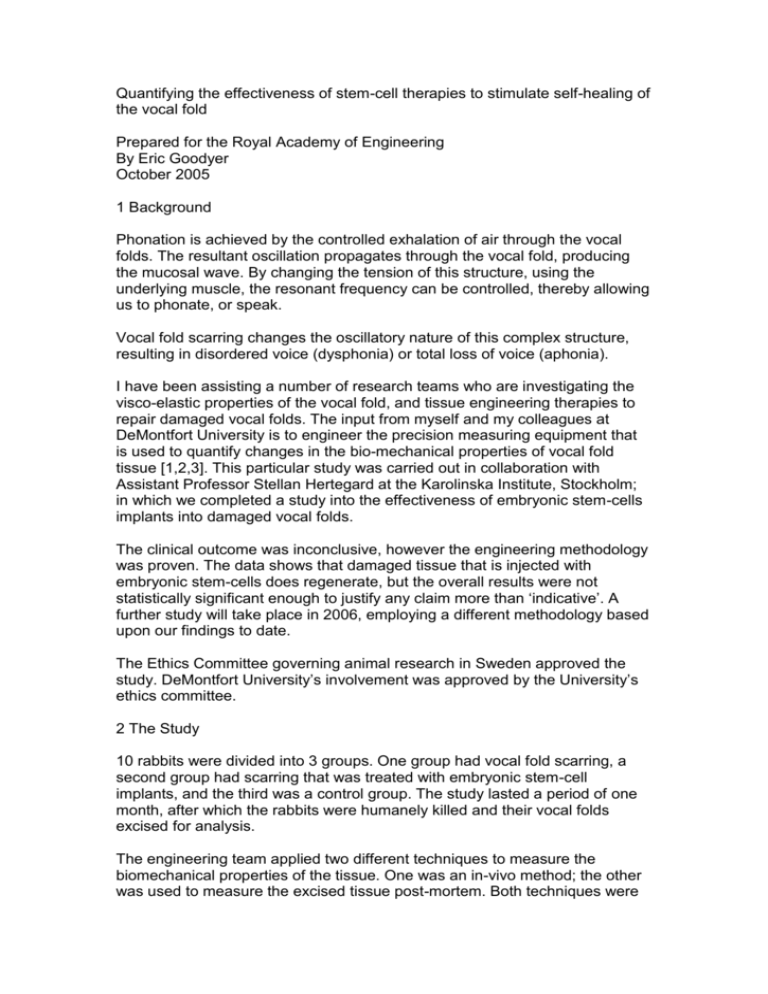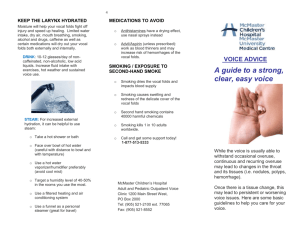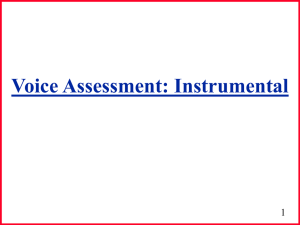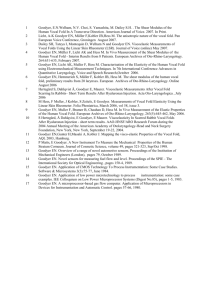RAE
advertisement

Quantifying the effectiveness of stem-cell therapies to stimulate self-healing of the vocal fold Prepared for the Royal Academy of Engineering By Eric Goodyer October 2005 1 Background Phonation is achieved by the controlled exhalation of air through the vocal folds. The resultant oscillation propagates through the vocal fold, producing the mucosal wave. By changing the tension of this structure, using the underlying muscle, the resonant frequency can be controlled, thereby allowing us to phonate, or speak. Vocal fold scarring changes the oscillatory nature of this complex structure, resulting in disordered voice (dysphonia) or total loss of voice (aphonia). I have been assisting a number of research teams who are investigating the visco-elastic properties of the vocal fold, and tissue engineering therapies to repair damaged vocal folds. The input from myself and my colleagues at DeMontfort University is to engineer the precision measuring equipment that is used to quantify changes in the bio-mechanical properties of vocal fold tissue [1,2,3]. This particular study was carried out in collaboration with Assistant Professor Stellan Hertegard at the Karolinska Institute, Stockholm; in which we completed a study into the effectiveness of embryonic stem-cells implants into damaged vocal folds. The clinical outcome was inconclusive, however the engineering methodology was proven. The data shows that damaged tissue that is injected with embryonic stem-cells does regenerate, but the overall results were not statistically significant enough to justify any claim more than ‘indicative’. A further study will take place in 2006, employing a different methodology based upon our findings to date. The Ethics Committee governing animal research in Sweden approved the study. DeMontfort University’s involvement was approved by the University’s ethics committee. 2 The Study 10 rabbits were divided into 3 groups. One group had vocal fold scarring, a second group had scarring that was treated with embryonic stem-cell implants, and the third was a control group. The study lasted a period of one month, after which the rabbits were humanely killed and their vocal folds excised for analysis. The engineering team applied two different techniques to measure the biomechanical properties of the tissue. One was an in-vivo method; the other was used to measure the excised tissue post-mortem. Both techniques were designed to take measurements from intact larynxes, which were split to reveal the vocal fold structure for the excised analysis. After testing using DMU’s equipment the vocal fold tissue was dissected out from the underlying layers, to be retested using a parallel plate rheometer, and samples were sent for histology. The objective is to obtain two sets of data from the excised vocal folds using different mechanical techniques; and to use the in-vivo technique to quantify the change in bio-mechanical properties with respect to time. The excised tests were successful; the in-vivo tests were not. 3 In-Vivo Tests We have been working in collaboration with Professor Markus Hess and his team at Eppendorf University Hospital, Hamburg, for a number of years. Over the last year we have successfully deployed a novel apparatus, the Laryngeal Tensiometer, that is able to measure the tensile strength of the human vocal fold. [4]. The instrument consists of a rigid clamp that is fixed to an adult laryngoscope, after it has been inserted into the mouth and larynx by the surgeon. A load cell is coupled to this arrangement such that the sensing element is located close to the view-port of the laryngoscope. A simple slide arrangement allows a user to move the load cell back and forth by a calibrated distance, which is set to 1mm. A magnetic coupling is fixed to the sensing element of the load cell. A 1mm diameter rod is inserted along the axis of the laryngoscope; the end of which is flattened such that it offers a platen (1mm x 2mm) to the vocal fold tissue. A water-based adhesive, methylcellulose, is used to attach the platen to the tissue. The other end of the rod is then fixed to the load cell using the magnetic attachment. Measurements are then taken by repeatably displacing the vocal fold tissue by 1mm and logging the change in resultant force. From this data it is possible to derive the Spring Rate of the vocal fold, and to convert that to a value for the shear modulus of the tissue using the known geometry of the experimental set up. It was this equipment that we attempted to use for this study. It was not successful due to the substantially smaller and different structures that are found in a rabbit as opposed to a human. In brief it was virtually impossible to create a clear line of site along the modified paediatric laryngoscope that we used from the load cell to the vocal fold. To obtain meaningful data the probe must not touch any other structures between the load cell and the vocal fold. We decided that it was unethical to continue to use this method. However, by chance, one specimen did offer an opportunity to take a measurement, as a clear visual path became available. The data was very noisy, and was perturbed by normal physiological actions, most notably breathing which was clearly visible as a slow rhythmic oscillation overlaying the data. We were able to estimate the shear modulus of one vocal fold at around 7792 Pa. 4 Excised Tests The equipment deployed for these tests was a modified Linear Skin Rheometer [5,6,7,8]. This apparatus consists of a load-cell that is mounted in a slide arrangement. Using a maxon miniature motor and a ball screw, the complete assembly can be accurately positioned. The position is measured using an LVDT. A chuck is fixed to the load cell sensor, such that it will measure forces that are in the same axis as the direction of movement of the slide arrangement. A range of different attachments have been developed that fit to the chuck, which are capable of obtaining data from the tissue under test in a variety of ways. For these tests a 1mm rod was fitted to the chuck, the other end of which is bent through 90 degrees and sharpened to give a needlepoint. The needlepoint was inserted into the vocal fold tissue, such that the direction of movement was 90 degrees to a line drawn between the anterior commisure and the vocal process. In effect this electro-mechanical arrangement enabled us to stretch the vocal fold in a similar direction to the motion of a mucosal wave. The tissue was cycled back and forth, by applying a sinusoidal force of +-0.5g at a rate of 1/3 Hz. The resultant displacement was logged at a rate of 1 kHz. A regression formulae solved for the best-fit sinusoidal wave to derive the peak force, the peak displacement and the phase shift between the two traces. From this data it is possible to calculate the Dynamic Spring Rate (DSR) of the test tissue, and to resolve the DSR into a purely elastic and a purely viscous term. For the purpose of this study our only interest is in the DSR. The purpose is to determine the mean DSRs for healthy tissue, damaged tissue and stem-cell treated tissue. Rabbit 0221 left 0247 right 0226 right 0221 right 0224 right 0212 right 0222 left 0227 left 0212 left 0222 right 0220 left 0247 left 0217 left 0222 right DSR g/mm 1.07 1.161429 1.32 1.348462 1.390909 1.392 1.403636 1.403636 1.47 1.518333 1.519 1.584 1.607143 1.796 CofV 0.026476 0.156514 0.070459 0.131648 0.087314 0.121953 0.039574 0.039574 0.097953 0.191315 0.079513 0.128426 0.021767 0.257763 modulus max Pa 5937.875 6445.252 7325.229 7483.176 7718.732 7724.787 7789.36 7797149 8157.641 8425.861 8429.562 8790.275 8918.705 9966.751 Scar type/treatment Small scar Big scar – treated Control Scar – treated Scar – treated Scar - treated Scar – treated Big scar – treated Scar Scar – treated Small scar Small scar – treated Big scar – treated Small scar – treated 0227 right 0224 left 0222 left 0220 right 1.796 1.811667 1.863333 1.867692 0.257763 0.135183 0.071905 0.120957 9966.751 10053.69 10340.41 10364.6 Big scar – treated Scar – treated Big scar – treated Control The table above gives the full set of results. Column 1 identifies the tissue sample, column 2 is the DSR is units of g/mm, column 3 is the coefficient of variance, column 4 is an estimate of the shear modulus of the tissue, and column 5 identifies what group the tissue belongs to. The results are ranked in terms of most pliable to most stiff. It can be seen that there are no statistically significant groups. One of the few points of interest is that tissue that has severe scarring, which would be expected to cluster near the bottom of table (very stiff) is represented throughout the table. This indicates that some form of healing did take place in some of these samples. Further tests are awaited, which will not be available in time for inclusion in this report. Samples of tissue will be subjected to histological analysis, to determine if there has been any measurable change in collagen and elastin constituents. The dissected out vocal fold tissue will then be tested using a parallel plate rheometer. This will give provide an alternative measurement of the tissue’s elastic properties. 5 Further Work Whilst inconclusive the results do indicate that some samples have demonstrated healing. This indication merits further analysis with a further study, which is constructed to provide an alternative method of obtaining statistically significant results. The main problem is that examples of the control group can be found throughout the table. This indicates that the natural variation in tissue pliability mitigates against finding significant clusters classified as healthy, scarred and treated. To overcome this problem a new study will be carried out in which each animal acts as its’ own control, by scarring & treating one side of the larynx. Whilst use of the pin has been well proven in previous studies, it is known that the variations in depth of penetration results in small discrepancies, and that the angle of tension with respect to the vocal fold axis is critical. Therefore in addition to carrying out direct measurements of shear we will in addition reconfigure the apparatus to operate as an indentometer. There exists a proven analytical method of deriving shear modulus direct from indentometer data [9,10]; and this method avoids the problems of both angle and depth. A further RAE travel grant will be requested to allow us to participate in this further study, which is planned for next year. 6 Dissemination We still await the histology and rheology results. However the data to date is indicative that severely damaged tissue injected with embryonic stem-cells did regenerate. We will therefore be disseminating these results in a peerreviewed journal. 1 2 3 4 5 6 7 8 9 10 Hertegård S, Dahlqvist Å, Goodyer E, Maurer. Viscoelasticity in scarred rabbit vocal folds after hyaluronan injection - short term results AAOHNSF/ARO Research Forum during the 2004 Annual Meeting of the American Academy of Otolaryngology-Head and Neck Surgery Foundation, New York, New York, September 19-22, 2004. Goodyer EN, Gunter H, Masaki A, Kobler J, AQL 2003, Hamburg, Mapping the visco-elastic Properties of the Vocal Fold Hess M, Mueller F, Kobler J, Zeitels S, Goodyer S. Measurements of Vocal Fold Elasticity Using The Linear Skin Rheometer, Folia Phoniatrica, in print. Goodyer EN, Hess M, Mueller F. In-vivo Measurements of the Human Vocal Fold. European Archives of Oto-Rhino-Laryngology in print. Matts PJ, Goodyer EN. Journal of Cosmetic Science, volume 49, pages 321323, Sep/Oct 1988, A New Instrument to measure the mechanical properties of the human stratum corneum. Matts PJ. The Linear Skin Rheometer. Stratum Corneum Podium Presentation Abstracts, item 23, – 10-12 Sep 1998, Cardiff. Mok W, Bautista B, Hoyberg K, Kirnos P, Subramanayam K.. Mechanical properties of ageing skin – Stratum Corneum vs. dermal changes. Stratum Corneum III, 12-14th September 2001, Basel Switzerland. Bioengineering of the Skin, Skin Biomechanics. Chapter 8 the Gas Bearing Electrodynamometer and the Linear Skin Rheometer. Published by CRC Press. ISBN 0-8493-7521-5 Hayes WC, Keer LM, Herrmann G, Mockros LF. A Mathermaticval Analysis for Indentation Tests of Articular Cartilage. J Biomechanics, 1972, Vol 5, 541555 Fung YC, Biomechnics: Mechanical Properties of Living Tissue. New York, Spriger Verlag 1981










